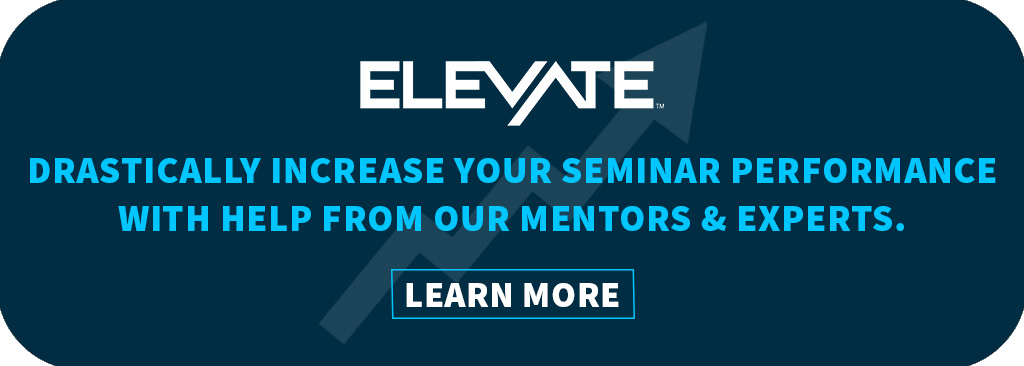Updated December 19, 2023, at 4:23 PM
What if you could know precisely what people are looking for to tailor your marketing and messaging around their financial concerns and consumer preferences?
A while back, we surveyed over 100 retail clients to gauge and provide insights into how you can increase engagement that drives your business forward as a financial professional. The survey results revealed what clients are most concerned with and the preferred mediums to use when communicating—among other things.
We took another look at the results and brainstormed some marketing and promotional tactics that you can put to use to help you connect with your clients and deliver on what they’re looking for from a financial professional.
Survey Data: Clients Concerned About Money in Retirement
According to our survey results, 54% of participants noted that their biggest concern in retirement is running out of money. It’s a valid concern and one you’re undoubtedly familiar with. Perhaps it’s due to clients not visualizing the mathematics behind how their current investments and finances will translate into a sustainable income, or maybe they’re spooked by the future of taxes, markets, and inflation.
Regardless, it’s a situation to be keenly aware of and one that’s not taken lightly. And since there’s no singular marketing strategy that can erase human emotion from the equation, strictly focusing your marketing efforts around financial concerns in retirement isn’t all that useful. Nearly every client or prospect you establish a relationship with will have these feelings in one way or another. However, you can use some small tactics to help ease your clients’ concerns while promoting your business and gaining more trust.
Marketing Tactics to Try
Promote and offer on-demand financial check-ins.
There’s a good chance you offer financial check-ins already, but maybe you do it on a quarterly, bi-annual, or annual basis. That’s all great to have in place, but a client’s financial feelings ebb and flow, sometimes daily. So when they’re fretting about potential upcoming tax legislation or a big life expense that’ll dwindle their savings, it’s nice to offer them peace of mind every step of the way. Understanding that financial concerns happen regularly (and offering a solution to that) will catch the eye of clients and prospects.
Here are some additional ideas to help you get your on-demand financial check-ins off and running:
- Every client is different, so offer these check-ins in several ways. You can utilize in-person meetings, Zoom calls, phone calls, or even create a templated PDF or PowerPoint that you can fill in and send along. Some clients may be shy or embarrassed about their concerns, so it’s best to offer check-ins in several ways that appeal to various personalities.
- Create visually appealing images or a short video to promote your on-demand check-ins. Market your service on your firm’s social media pages, website, and even through one-on-one emails. Launching email campaigns so prospective and current clients are fully aware of your value-add is also an idea to consider.
- Take it a step further. If you’re meeting in person, offer to buy lunch from your client’s favorite spot in town. Or, send out financial wellness goodie bags after each on-demand check-in that includes items like a simple budget tracker or branded piggy bank. You can even offer an App Store or Google Play Store gift card with a personal note encouraging them to download their favorite financial planning app or book to help them stay involved.
Related: The Financial Professional’s Inbound Marketing Funnel [Infographic]
Offer branded and downloadable financial “to-do lists” across your firm’s digital footprint.
Retail investors aren’t always keenly aware of the steps and tips needed to stay on top of their finances. And even if they are, it’s another chore to keep track of all the steps they take throughout the year.
Another recommended approach to take with those concerned about retirement money is to take the time to create a well-designed and branded PDF or Word document that includes an in-depth financial to-do list to offer clients and prospects. This value-add tactic is a useful way to ease the minds of clients concerned about retirement money. It’ll also help them take the proper steps towards achieving their goals.
After the downloads start pouring in, don’t forget to check up on those who downloaded the list. After a month or so, see how they’re feeling about their finances. This makes for an excellent time to address their concerns and find solutions to their needs.
For maximum effectiveness, you can offer this financial to-do list through:
- Your firm’s website while using a form to capture new leads
- Your social media pages, providing a link to download the list in your post
- Personal emails to re-engage clients you haven’t spoken with recently
Survey Data: Clients Say Trustworthiness Most Important
When looking into a local brand or organization to become involved with, 65% of the survey’s participants indicated that the brand’s trustworthiness is the most critical trait they desire. So, how can you create and maintain trust in your firm?
A firm’s trustworthiness goes well beyond marketing strategies, but that doesn’t mean there aren’t ways you can prove your trustworthiness through your marketing strategy and tactics. Here are a few you can try.
How to Build Trust with Clients in Your Marketing
- Create a personalized client experience. Everyone enjoys personalization these days, so give your clients what they want. To dive deep into personalization, you first must have a deep understanding of each client’s priorities and preferences and then segment your clientele when it makes sense.
If you have clients who stated they’re not interested in life insurance for at least five years, then maybe leave their emails out of that next email campaign on life insurance policy dos and don’ts. Or, if you know a client is vegetarian, make sure to have plenty of veggie options at your next client appreciation barbeque. These adjustments may seem small in your overall marketing strategy. Still, keeping a detailed record of each client, their likes and dislikes, and even things they’ve mentioned in passing can help build stronger relationships through your marketing and branding. - Embrace transparency. People want to know what they can expect from your business. And if they don’t get that answer upfront, it can lead to issues down the road if they perceive that their wants or needs aren’t being met. It’s a prime reason why being transparent about your fees, processes, data usage, and partnerships can be so crucial to financial planning firms. That means being honest and almost oversharing information in your marketing. The less information clients have, the more their minds may start wondering, guessing—or worse, assuming—what the truth is.
- Create consistency. To build your brand’s trust, it pays to be consistent in your branding and messaging. Sure, that bright orange font you used in your last email or website pop-up may seem fun and “pop” to your eyes, but if your brand colors are black and gold and you traditionally stick to those colors, you’ll likely get more confusion than excitement from your audience.
Becoming strategically repetitive in your marketing materials won’t happen overnight. But if you can create writing style guides and branding style guides (or at least have set rules in your head), your marketing will instantly become higher quality. Over time, your clients and prospects will build trust with your precision messaging and consistent branding time after time. - Take accountability in your thought leadership. It’s no secret your clients view you as a financial expert, and prospects presumably do the same. Otherwise, they wouldn’t be giving you the time of day. Another way to build more trust through your marketing efforts is to engage in thought leadership, create helpful content, and solve people’s problems.
Related: How to Promote a Podcast Appearance in 10 Easy Steps
Survey Data: Clients Split on Staying Informed
There’s some great news here, but it does require you to be diverse in your offerings. But as a financial professional, you’re used to that anyway.
According to our survey results, when it comes to a preferred method of being informed, clients are split.
- 22% of respondents prefer speaking over the phone
- 19% prefer tuning into a webinar presentation
- 19% want to watch on-demand videos
- 18% want to read a written report or article
These findings aren’t as one-sided as the other results, but it offers a glimpse into the value of a cross-channel marketing approach—especially when it comes to your educational content.
We hear “be everywhere all at once” a lot today, and this rings true for your firm’s marketing and content. But if you’re like most small businesses, you don’t have the resources to create brand-new webinars, email campaigns, videos, blog posts, or whitepapers regularly. But what you probably do have the resources for is repurposing your already-created content into different content forms to ensure maximum engagement among your audience.
Below are some quick ideas to create more agile and comprehensive content.
Ideas for Repurposing Your Content
- Turn webinars into client guides. Over the years (and especially in 2020), you’ve probably hosted plenty of webinars to the point you could recite your talking points in your sleep. You can turn all that great information into written guides for clients who want to take their time and read independently. You may need to go into a little more detail depending on the webinar’s content, but that shouldn’t stop you. Providing clients with another avenue to learn in-depth information is never a bad idea.
- Use newsletter or email content and make a short video. If you offer clients a monthly or quarterly newsletter or engage with them via email campaigns regularly, I’ll be frank with you: not everyone reads them. For those who don’t—and even those who do—you can turn that impactful content into short videos that you can share across your social media channels.
Not only does it give your clients another way to consume your content, but it also engages with prospects and new audiences via your social sites. Video is one of the most engaging mediums you can use, and posts with videos get 1,200% more social shares than text and images combined. - Make a blog post or whitepaper into an on-demand webinar. There are probably some blog posts or client-facing whitepapers in your content arsenal that address some common client concerns or financial strategies to pursue. If that’s the case, take as many as time allows and turn them into pre-recorded webinars to share via email and social media. Webinars have been a huge success lately, so it’s a win-win for you and your clients to have ones already built and ready to send or post.
- Create phone scripts from a recent PowerPoint presentation. Our survey results were clear: people still love talking on the phone with an expert. But sometimes as the expert, it’s not always easy going entirely off your memory and knowledge. Even the best presenters are prone to slip-ups this way. Having an outline or script can help you stay calm and collected throughout your conversation. One way to fill in the information you want to present over the phone can be in the form of PowerPoint presentations or slideshows. All that information you want to convey is already there, so jot down your talking points and use them in your next phone call to give clients a smooth and professional experience.
Closing Thought
Hopefully, this small sample of survey results can lend a helping hand to further developing your firm’s marketing strategies and tactics. These insights provide you a glimpse of what today’s clientele are looking for from their financial professional. Get started on implementing these marketing ideas today to find how you can effectively deliver on those desires.
Keep Reading: How SEO for Financial Professionals Can Grow Business


